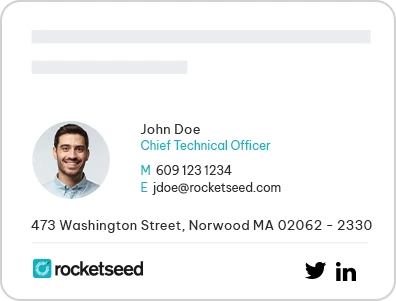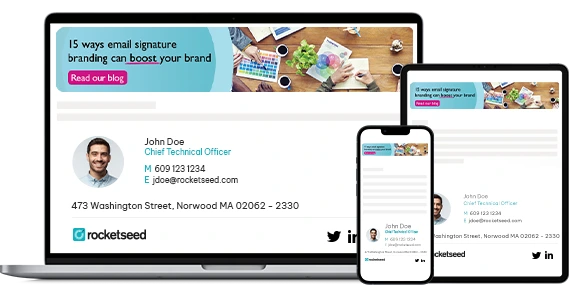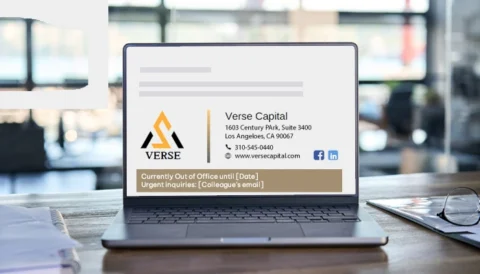
An effective email signature is one that includes various different elements. These can include everything from a headshot picture to interactive social media icons. Yet there’s one specific element that sits above the rest in terms of importance: your contact details.
Your contact details are essential for numerous reasons. The most obvious reason is that they supply email recipients with valuable information about how they can get in touch with you. For those who don’t want to simply respond to your email, they can contact you by phone, for instance. It also allows people to find you effortlessly on the likes of Twitter and LinkedIn. Additional contact details also help with verifying your identity.
With the significance of contact information, it is vital you get this part of your email signature right. The following best practices show you how it’s done.
Avoid adding all your contact details
Yes, your contact details are crucial for an email signature. No, you don’t have to include every single piece of contact information you possess. This is particularly the case if you have multiple email addresses, phone numbers, website URLs, and so on. Include too much contact information, and recipients will be quick to label you as desperate rather than professional!
Only incorporate your essential contact details. These include your full name, position, company name (if it isn’t incorporated in your logo), phone number, email address, website URL, and social media profiles. All of your contact details should never exceed seven lines in your email signature.
Go beyond this number, and your signature becomes increasingly untidy and difficult to read. If possible, try and spread your contact details across four or five lines in total.

Keep your details up to date
An email signature’s main purpose is to supply your recipients with contact details. That aspect quickly becomes redundant if your information isn’t up to date.
Your contact information can change for numerous reasons. You might take up a different job role. You could change your phone number. You may start using a new social media platform. Either way, when a relevant change does occur, you need to update your email signature to reflect this change.
What if you want to manage the signature contact details of everyone in your company? That’s when you need central signature control so you can update all (say, for a change of office address) or any individual’s contact details (such as a change in job title) when required. To make things even easier, email signature software like Rocketseed integrates with your Active Directory so when an employee’s details are updated in the Directory, their corresponding signature details update automatically.
Include your full name
All too often, people who are crafting their email signature make a large error: they don’t include their full name. They will simply go with their forename and think this is enough. Well, this guide is here to tell you, no, it’s not good enough!
A single name entry is unprofessional. It’s that simple. Recipients won’t view your email signature in a favourable light if they’re presented with a simple ‘Julie’ or ‘Andy’. The top of your signature should present your first and last name – no exception. You might also decide to include a middle name or initial. Avoid nicknames.
Yes, still add your email address
You’re sending an email. Why would you need to include your email address within your email signature? Surely that’s pointless? Can’t a recipient simply look at the ‘From:’ field and gain your email address that way?
That’s what some other guides pertaining to email signatures will tell you. However, you should always add your email address. Certain email platforms, such as Outlook, utilise display names in the ‘From:’ field rather than email addresses. While it helps enhance familiarity and readability, it becomes problematic once your email is forwarded on. Rather than showing your email address to the new recipient, it only reveals your display name.
That’s not good if that person wants to send you an email. At least, that’s the case if you don’t add your email address to your signature. Include a ‘mailto:’ link, and it makes it even easier for them to respond.
Add your social media accounts
In this day and age, more and more people are skipping other communication options to chat via social media. Due to this, you should provide an easy way for recipients to land on your social media pages.
To prevent cluttering up your email signature with text, use on-brand social media icons with corresponding URL links, giving you a neat, eye-catching and engaging element for your signature.
Just remember that your email signature is not a place to promote personal social media pages. They should only correlate with your professional career. For example, if you have a personal Twitter profile that is generally used to post memes, react to political news, curse your favourite football team, etc., you don’t want to link to this through your professional business email signature.

Stay on brand
They might be your essential contact details but they are still part of your signature branding so make sure you keep your font styles and colours in line with your brand guidelines. This is another example where central control solves the problem when managing email signatures at scale. By using email signature software such as Rocketseed, the format of all contact details is designed centrally and all employee contact details are automatically formatted consistently to this design (and stay tamper-proof in case individual’s get tempted to get ‘creative’!)
Contact details are the most essential part of email signatures. However, keeping them complete, up to date and on brand can be a challenge, especially across every employee in your business. As we’ve shown, the secret to managing email signatures at scale is centralised control. To find out how simple this can be, schedule a demo.
Shanique Brophy | Marketing Executive
Connect with Shanique on LinkedIn




